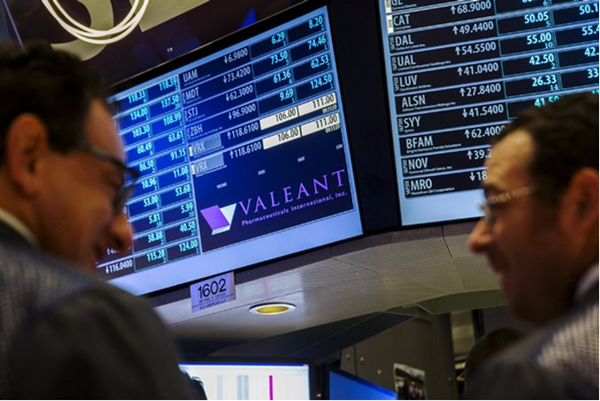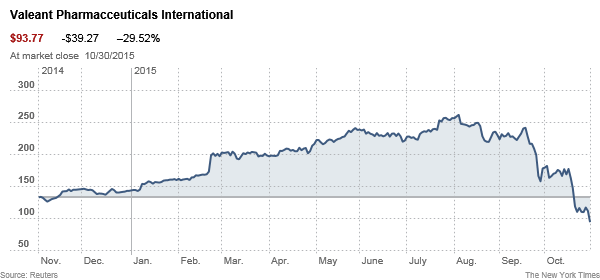
Business Day
Valeant Shows the
Perils of Fantasy Numbers
OCT.
30, 2015
|

Valeant's market value has fallen
by more than $50 billion since August. Credit Lucas
Jackson/Reuters.
Credit Lucas Jackson/Reuters
|
Investors often say they learn more from investment losers than from
winners. That suggests that Valeant, the beleaguered pharmaceutical
company whose market value has fallen by almost $60 billion since
August, offers a bounty of teaching moments.
Let’s
start with the perils of relying on earnings forecasts and stock
valuations based on fantasy rather than reality. Such a reliance may
have lulled some recent investors into believing they were paying a
small premium to own Valeant shares when in actuality it was costing
them the moon. (The stock is still a winner for those who bought
shares before the autumn of 2013.)
| |
Fair Game
A
column from Gretchen Morgenson examining the world of finance
and its impact on investors, workers and families
See More »
|
| |
|
Valeant is among a growing number of companies that regularly present
two types of financial results: those that adhere to generally
accepted accounting principles, and those that help executives put the
best spin on their operations.
In accounting
parlance, such adjusted figures — which exclude certain costs from calculations
of a company’s earnings — are known as pro forma or non-GAAP numbers. But let’s
call them what they really are: a false construct.
Valeant is among
a growing number of companies that regularly present two types of financial
results: those that adhere to generally accepted accounting principles, and
those that help executives put the best spin on their operations.
In accounting
parlance, such adjusted figures — which exclude certain costs from calculations
of a company’s earnings — are known as pro forma or non-GAAP numbers. But let’s
call them what they really are: a false construct.
Part of the
problem with these adjustments lies in the freedom companies have to choose
which costs they want to strip out. One company may exclude stock compensation
costs from its earnings calculations while another in the same industry does
not. That makes it difficult to compare the two companies’ operations.
The tide of
companies making up their own earnings calculations is rising, said Jack
Ciesielski, publisher of
The Analyst’s Accounting Observer. In a
recent report, he noted that 334 companies in the Standard & Poor’s 500-stock
index reported non-GAAP earnings last year, up from 232 such companies in 2009.
The dollar amount of cost adjustments made to those companies’ profits totaled
$132 billion last year, more than double the amount in 2009.
“There is a lot
more of this going on,” Mr. Ciesielski said in an interview. “The companies are
really pushing it.”
This creativity
is common practice in the pharmaceutical industry, so Valeant is certainly not
atypical. But the difference between the company’s real earnings and its
adjusted numbers is far greater than it is for its large competitors, making
Valeant a prime example of this problem.
In
news releases, Valeant executives
are careful to include their results under accounting rules. But these
communications tend to focus more on the company’s primary
hand-tailored figure — what it calls “cash E.P.S.” When providing
forecasts, for example, the company supplies only pro forma numbers.
Valeant strips out a laundry list of expenses from its revenue,
including those related to stock-based compensation, legal settlements
and costs associated with restructuring and acquisitions.
Most
significant, perhaps, for Valeant are costs related to acquisitions. Generally
accepted accounting principles require companies to recognize over time the
diminishing value of intangible assets they acquire when buying another company
— or amortization. Valeant excludes those costs.
At Valeant, an
acquisitive company, this is a big number. This year alone, Valeant has paid $15
billion for six deals in which terms were disclosed.
Excluding
acquisition-related costs from its pro forma figures, including amortization,
makes the company look far more profitable than it is.
The company says
it publishes pro forma figures to provide investors with “a meaningful,
consistent comparison of the company’s core operating results and trends for the
periods presented.” Valeant goes into detail on the expenses it is excluding, so
diligent investors can do their own analyses.
A spokeswoman
for the company declined to comment further.
Valeant took
another blow on Thursday when the nation’s three largest drug benefit managers
said they would stop doing business with a pharmacy that sold Valeant products.
The hedge fund manager William A. Ackman, who is one of Valeant’s biggest
stockholders, defended the company in a marathon three-hour conference call on
Friday, yet its stock continued to plummet.
Looking at
Valeant’s real earnings compared with its make-believe ones exposes an enormous
gulf. Under generally accepted accounting principles, the company earned $912.2
million in 2014. But Valeant’s preferred calculation showed “cash” earnings of
$2.85 billion last year. That gap is far wider than at other pharmaceutical
companies presenting adjusted figures.
It’s easier to
justify paying up for a stock when you’re relying on ersatz results. Valeant’s
shares, at their peak of $262, were trading at 98 times 2014 earnings. Set
against the fantasy figures, though, the stock carried a multiple of just 31
times. Not a bargain, perhaps, but also not insane.
Valeant’s History of Deal Making
The drug company is known for
growing through acquisitions and cutting costs.
-
BIOVAIL
The drug company was created in a merger of Biovail of Canada
and a predecessor company based in Aliso Viejo, Calif.
(2010)
-
CEPHALON
The biopharmaceutical company
rejected a bid from Valeant
as opportunistic and too low. (2011)
-
MEDICIS
Valeant agreed to buy the dermatological drug company for
about $2.6 billion. (2012)
-
ACTAVIS
Merger talks fell through after a number of concerns from the
target company’s directors, including the size of the deal
premium. (2013)
-
BAUSCH & LOMB
The eye care company sold itself for about $8.7 billion,
sidestepping an I.P.O. (2013)
-
ALLERGAN
The company, maker of Botox, rejected an
unusual hostile bid from
Valeant and a hedge fund. Valeant was
criticized in the
bitter takeover battle
for
cutting R.&D. (2014)
-
SALIX
Faced with the prospect of letting another deal slip through
its fingers, Valeant substantially raised its bid, putting a
quick end to a bidding war. (March 2015)
-
SPROUT
Two days after winning regulatory approval for the first pill
to aid a woman’s sex drive, the company was acquired.
(August 2015)
|
|
Given
that the Securities and Exchange Commission requires companies
reporting pro forma figures to publish GAAP numbers in tandem, you
might assume investors would stay focused on the facts. But academic
research appears to show that adjusted numbers drive stock prices.
Consider a
2002 study on non-GAAP numbers by
Mark T. Bradshaw, an associate
professor of accounting at Boston College, and
Richard G. Sloan, a professor of
accounting at the University of California, Berkeley. The fantasy
numbers had “displaced GAAP earnings as a primary determinant of stock
prices,” its authors wrote.
In an interview,
Mr. Sloan said he was concerned about the proliferation of companies reporting
non-GAAP figures and the challenges that posed to investors.
“I can see the
advantages of letting a company with a good management team do its own voluntary
disclosure to help investors understand over and above what’s in the GAAP
filings,” Mr. Sloan said. “But what goes along with that is companies that use
their own numbers to put them in a better light and to mislead investors.”
Helping
perpetuate these kinds of earnings myths, Mr. Sloan said, are Wall Street
analysts who use companies’ invented figures in reports and stock price
forecasts.
“You’d hope that
Wall Street analysts would recognize you can’t really value a company like
Valeant whose business model is to pay cash to make acquisitions by ignoring the
amount of cash it is using in those acquisitions,” Mr. Sloan said.
Recent Wall
Street research on Valeant highlights this problem. In an Oct. 1 report from
Morgan Stanley, Valeant’s pro forma earnings are identified as “E.P.S.,” leading
many readers to assume a GAAP number. A figure identified in a table as net
income is actually Valeant’s adjusted number, which is far larger than the GAAP
version.
Two recent UBS
reports are also confusing. On Page 1 of both reports, the analyst cited
Valeant’s pro forma figure as “E.P.S.” Later in the report, the analyst
identified the figures as “cash E.P.S.”
At Merrill
Lynch, the Valeant analyst does a better job, presenting both GAAP and pro forma
figures so investors can see the vast differences between the two.
Analysts may
feel compelled to use a company’s adjusted numbers when they reflect standard
industry practice. At the same time, however, going along with a numbers game
may also be a way to stay on good terms with a company’s executives. Analysts
who exert independence can find that managers may refuse to answer their
questions or otherwise turn off the crucial information spigot.
Back in 2003,
after pro forma earnings had begun to gain traction, the S.E.C. wrote a new rule
to try to help investors. Known as
Regulation G, it requires companies using
fantasy figures in regulatory filings to present “with equal or greater
prominence,” comparable financial measures calculated under GAAP. The regulation
does not cover news releases.
Mr. Sloan thinks
it may be time for a new rule. “When they did Reg G, things calmed down for a
little bit,” he said. “Now things are getting out of control again.”
A version of this article appears in print on November 1, 2015, on
page BU1 of the New York edition with the headline: Valeant’s
Fantastic(al) Numbers.
© 2015 The
New York Times Company

